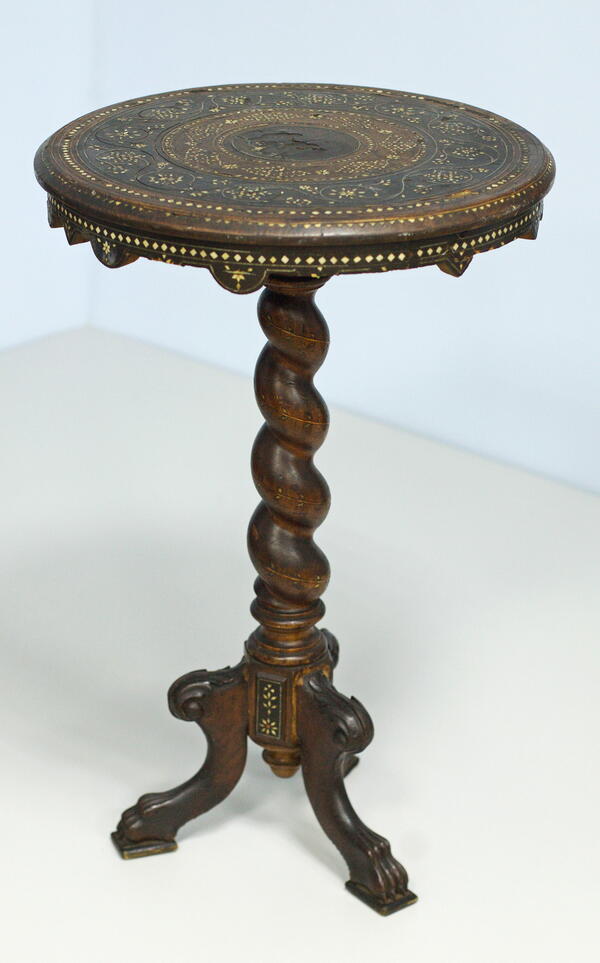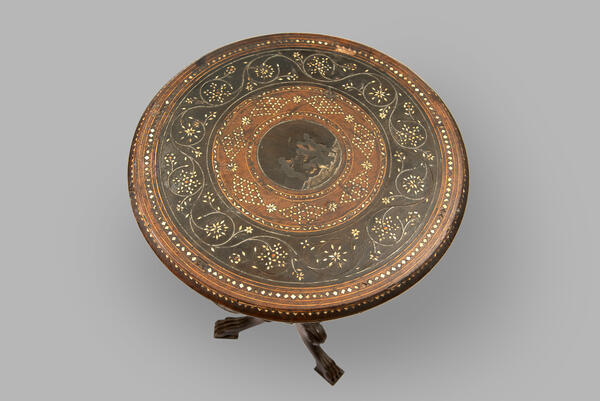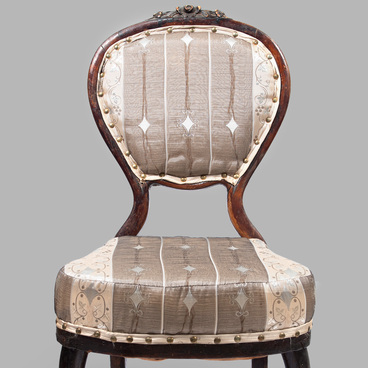The small round table, displayed in the Kirsanov Local History Museum, is part of the furniture set from the Obolensky estate in the village of Ira. This set was a source of great pride for the owners and invariably drew the delight and admiration of the estate’s guests. The last owner of the estate in the village of Ira was Maria Konstantinovna Reitern. Born Naryshkina, from 1878 to 1897 she was married to Prince Obolensky-Neledinsky-Meletsky (1850-1913). After her divorce, she married Alexander Maximovich Reitern (1849-1915).
Maria Konstantinovna Reitern owned a large estate in Kirsanov District: she owned around 5,000 dessiatinas of land and forest areas. The heart of Maria Konstantinovna’s estate was a large wooden house on a high stone foundation with three entrances. The upper two floors were used by the owner of the manor and her visiting guests. The rooms were luxuriously decorated with parquet flooring and carved furniture which gave the impression of a very rich home. The ground floor had a kitchen and servants’ quarters (up to 30 people). In the basement there were storage rooms and a wine cellar where stocks of Rheinwein were kept. According to legend, a high tower was attached to the house, offering a view of the surrounding countryside. In front of the house there was a fountain. The manor territory was surrounded by a bund with a ditch and guarded by Circassians hired after 1905.
The Obolenskys’ furniture set on display at the Kirsanov Museum consists of nine pieces: a table, a mirror, a small round table, a bedside table, and five different chairs. The pieces of the set, different in form, share their decorative finish and design elements. The surfaces and parts of the furniture are inlaid with geometric ivory patterns and decorated with panels depicting genre scenes. The round single-leg table is called a “gueridon”. The piece comes from Louis XIV France. The compact round tables with shaped legs were originally used to support candelabrums. But later they were used to put flower and fruit vases, figurines and photographs, and in Russia, samovars were placed on the gueridons, turning them into tea tables.
In March 1917, Reitern’s estate was vandalized and looted by soldiers and peasants who had deserted from the front. The princess herself died in exile in Paris in 1929. The furniture set in the Kirsanov Local History Museum shows the wealth and splendor associated with this noble estate.
Maria Konstantinovna Reitern owned a large estate in Kirsanov District: she owned around 5,000 dessiatinas of land and forest areas. The heart of Maria Konstantinovna’s estate was a large wooden house on a high stone foundation with three entrances. The upper two floors were used by the owner of the manor and her visiting guests. The rooms were luxuriously decorated with parquet flooring and carved furniture which gave the impression of a very rich home. The ground floor had a kitchen and servants’ quarters (up to 30 people). In the basement there were storage rooms and a wine cellar where stocks of Rheinwein were kept. According to legend, a high tower was attached to the house, offering a view of the surrounding countryside. In front of the house there was a fountain. The manor territory was surrounded by a bund with a ditch and guarded by Circassians hired after 1905.
The Obolenskys’ furniture set on display at the Kirsanov Museum consists of nine pieces: a table, a mirror, a small round table, a bedside table, and five different chairs. The pieces of the set, different in form, share their decorative finish and design elements. The surfaces and parts of the furniture are inlaid with geometric ivory patterns and decorated with panels depicting genre scenes. The round single-leg table is called a “gueridon”. The piece comes from Louis XIV France. The compact round tables with shaped legs were originally used to support candelabrums. But later they were used to put flower and fruit vases, figurines and photographs, and in Russia, samovars were placed on the gueridons, turning them into tea tables.
In March 1917, Reitern’s estate was vandalized and looted by soldiers and peasants who had deserted from the front. The princess herself died in exile in Paris in 1929. The furniture set in the Kirsanov Local History Museum shows the wealth and splendor associated with this noble estate.




